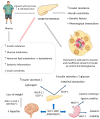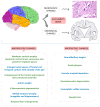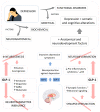GLP-1a: Going beyond Traditional Use
- PMID: 35054924
- PMCID: PMC8775408
- DOI: 10.3390/ijms23020739
GLP-1a: Going beyond Traditional Use
Abstract
Glucagon-like peptide-1 (GLP-1) is a human incretin hormone derived from the proglucagon molecule. GLP-1 receptor agonists are frequently used to treat type 2 diabetes mellitus and obesity. However, the hormone affects the liver, pancreas, brain, fat cells, heart, and gastrointestinal tract. The objective of this study was to perform a systematic review on the use of GLP-1 other than in treating diabetes. PubMed, Cochrane, and Embase were searched, and the PRISMA guidelines were followed. Nineteen clinical studies were selected. The results showed that GLP-1 agonists can benefit defined off-medication motor scores in Parkinson's Disease and improve emotional well-being. In Alzheimer's disease, GLP-1 analogs can improve the brain's glucose metabolism by improving glucose transport across the blood-brain barrier. In depression, the analogs can improve quality of life and depression scales. GLP-1 analogs can also have a role in treating chemical dependency, inhibiting dopaminergic release in the brain's reward centers, decreasing withdrawal effects and relapses. These medications can also improve lipotoxicity by reducing visceral adiposity and decreasing liver fat deposition, reducing insulin resistance and the development of non-alcoholic fatty liver diseases. The adverse effects are primarily gastrointestinal. Therefore, GLP-1 analogs can benefit other conditions besides traditional diabetes and obesity uses.
Keywords: Alzheimer’s disease; Parkinson’s disease; depression; diabetes; glucagon-like peptide-1; non-alcoholic fatty liver disease; obesity; visceral insulin resistance adiposity syndrome.
Conflict of interest statement
The authors declare no conflict of interest.
Figures










References
Publication types
MeSH terms
Substances
LinkOut - more resources
Full Text Sources
Other Literature Sources

